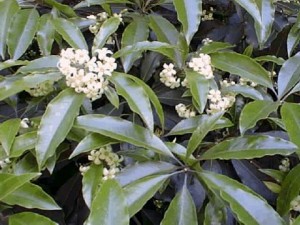Fragrant Plant in Southern California
 Question from Eileen:
Question from Eileen:
I am trying to identify the plant which perfumed the air when I made a recent trip to St. Louis Obispo, Ca. The fragrance was everywhere I went. It was delightful and was so persistent that it must grow wild. I would like to identify it. I live in Missouri.
Answer from Pat:
Since you went to San Luis Obisbo in April or May and were struck by a very fragrant plant which you smelled everywhere, my guess is that it was Victorian box (Pittosporum undulatum). Pittosporum undulatum is a large shrub or small-to-medium size evergreen tree from eastern Australia often found in old established gardens in the mild coastal climates of Southern California. It’s invasive in warm-winter climates, thus it often seeds itself in irrigated gardens but cannot survive in wild lands unless there is a stream or other water source. It is drought-resistant along the coast, but needs regular irrigation inland.
Victorian box has a number of virtues. It has dense, clean green foliage, no pests, and creamy-white blossoms in spring that are not particularly showy but are wonderfully fragrant. One can clip it into a high informal hedge or let it grow into a tree. If a hedge ever gets too tall you can cut it down lower, even all the way to the ground if you want, and it will sprout and grow again. When this shrub or tree is in bloom in spring and when it has spread through many gardens, the utterly delightful fragrance may waft on the breeze throughout an entire town for about a month every spring. It is especially strong in the evening. Bunches of round seed pods take the place of flowers in summer. In fall they turn orange, and in December or January, they open and sticky seeds onto the ground or pavement. Birds love the seeds and spread them around to many gardens. The seeds also stick to animals’ feet and people’s shoes which are additional ways of spreading them. The seeds sprout easily in the winter rains. Victorian box is a pest plant in Hawaii since regular rainfall allows it to proliferate in wild lands. Here in California our seasonal rains confine it to irrigated gardens in USDA Zones 9 and 10. It cannot survive cold winters. If you live in Zone 9 or 10 you should be able to grow this tree, but check first that it is not on the list of noxious pest plants in your region. When rainfall is year-round, exotic species that need moisture and have invasive characteristics can spread into wild lands where they can choke out natives.


Excellent article on year round color. I will be creating this type of garden can you give me suggestions on different plants to use to create that effect year round.
Thanks
Hector